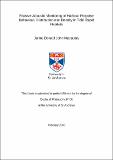Files in this item
Passive acoustic monitoring of harbour porpoise behaviour, distribution and density in tidal rapid habitats
Item metadata
| dc.contributor.advisor | Northridge, Simon P. | |
| dc.contributor.advisor | Gordon, Jonathan | |
| dc.contributor.advisor | Gillespie, Douglas | |
| dc.contributor.author | Macaulay, Jamie Donald John | |
| dc.coverage.spatial | 273 p. | en_US |
| dc.date.accessioned | 2021-02-24T15:41:43Z | |
| dc.date.available | 2021-02-24T15:41:43Z | |
| dc.date.issued | 2020-12-01 | |
| dc.identifier.uri | https://hdl.handle.net/10023/21499 | |
| dc.description.abstract | Toothed whales produce regular echolocation clicks to sense their surroundings and hunt. These clicks can be detected on hydrophones allowing researchers to study and monitor animals, a methodology known as passive acoustic monitoring (PAM). PAM methods can be used to detect behaviours such as foraging, calculate the absolute abundance and determine the 3D positions of soniferous animals. However, this requires robust detection, species classification and localisation algorithms alongside a statistical framework to estimate animal density. Detection, classification and localisation methods were developed to obtain fine scale behavioural information of toothed whales which was then integrated with a distance sampling-based framework to estimate density. These methods were applied to calculate the behaviour, 3D distribution and density of harbour porpoises in a tidal stream habitat. Toothed whales produce clicks in sequences (clicks trains) which can provide information on behavioural state and aid in species identification. A click train detection algorithm was developed to extract these sequences and performance then tested on PAM data from sperm whales, delphinids and harbour porpoise datasets. Localisation in tidal rapids is difficult due to fast moving currents and high densities of toothed whales producing a complex soundscape. A drifting free-hanging vertical hydrophone array with movement sensors, click aliasing and track association algorithms was developed to collect geo-referenced 3D tracks of toothed whales in tidal streams. The full 4π beam profile of a free-swimming captive harbour porpoise was measured. This showed that harbour porpoises have significant acoustic energy at extreme off-axis angles (>30°) which has implications for detectability on PAM devices. Drifting sound recorders and vertical hydrophones arrays were used to survey a tidal rapid site. Detected click trains, dive data and the measured beam profile were used to inform simulations of detection probability of harbour porpoise clicks and calculate animal density and foraging rates. | en_US |
| dc.description.sponsorship | "This PhD was supported by the University of St Andrews (School of Biology); the Scottish Government [Marine Mammal Scientific Support Research Programme MMSS/002/15 and Marine Mammal Scientific Support Research Programme MMSS/001/11]; Department of Environment and Rural Affairs [MB5203/RMP5862 Cetacean Bycatch Observer Monitoring Scheme and MB5203/RMP5862 Cetacean Bycatch Observer Monitoring Scheme] and NOAA Fisheries [Bycatch Reduction Engineering Program]" -- Funding | en |
| dc.language.iso | en | en_US |
| dc.publisher | University of St Andrews | |
| dc.rights | Creative Commons Attribution 4.0 International | * |
| dc.rights.uri | http://creativecommons.org/licenses/by/4.0/ | * |
| dc.subject | Harbour porpoise | en_US |
| dc.subject | Passive acoustic monitoring | en_US |
| dc.subject | Acoustic localisation | en_US |
| dc.subject | Tidal rapids | en_US |
| dc.subject | Tidal habitats | en_US |
| dc.subject | Click train detection | en_US |
| dc.subject | Beam profile | en_US |
| dc.subject | Density estimation | en_US |
| dc.subject.lcc | QL737.C434M2 | |
| dc.subject.lcsh | Harbor porpoise--Monitoring | en |
| dc.subject.lcsh | Harbor porpoise--Behavior | en |
| dc.subject.lcsh | Acoustic localization | en |
| dc.title | Passive acoustic monitoring of harbour porpoise behaviour, distribution and density in tidal rapid habitats | en_US |
| dc.type | Thesis | en_US |
| dc.contributor.sponsor | University of St Andrews. School of Biology | en_US |
| dc.contributor.sponsor | Scotland. Marine Mammal Scientific Support Research Programme | en_US |
| dc.contributor.sponsor | Great Britain. Department for Environment, Food & Rural Affairs (DEFRA) | en_US |
| dc.contributor.sponsor | United States. National Oceanic and Atmospheric Administration (NOAA) | en_US |
| dc.type.qualificationlevel | Doctoral | en_US |
| dc.type.qualificationname | PhD Doctor of Philosophy | en_US |
| dc.publisher.institution | The University of St Andrews | en_US |
| dc.identifier.doi | https://doi.org/10.17630/sta/34 |
The following licence files are associated with this item:
This item appears in the following Collection(s)
Except where otherwise noted within the work, this item's licence for re-use is described as Creative Commons Attribution 4.0 International
Items in the St Andrews Research Repository are protected by copyright, with all rights reserved, unless otherwise indicated.


